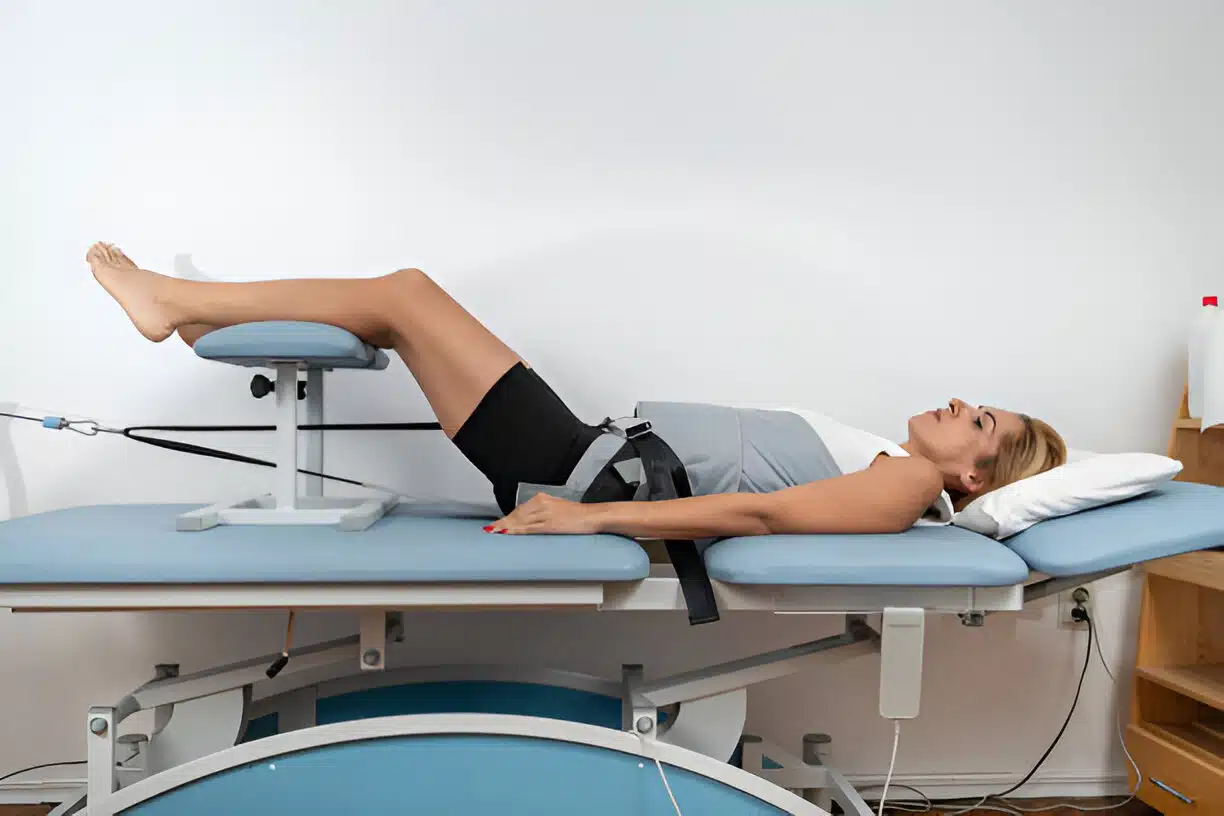
Are you experiencing back pain, herniated discs, or spinal compression? Traction therapy may offer the relief you need. This non-invasive treatment gently stretches the spine to reduce pressure on discs, nerves, and joints, promoting pain relief and improved mobility.
Traction therapy works by creating space between the vertebrae, which can help alleviate nerve compression, improve circulation, and encourage natural healing. It is commonly used to treat conditions such as sciatica, degenerative disc disease, and spinal misalignment. Whether performed manually or with mechanical devices, traction therapy can provide long-term benefits by improving posture, flexibility, and spinal health.
If chronic back pain or stiffness is affecting your daily life, traction therapy could be an effective solution. A tailored treatment plan can help you restore function, reduce discomfort, and improve overall spinal well-being. Learn more about our comprehensive wellness services at Washington Wellness Center in Robbinsville Township, NJ.





At Washington Wellness Center, we proudly offer Traction Therapy as a specialized service designed to alleviate pain and promote healing in the spine and surrounding areas. This non-invasive treatment uses targeted stretching and decompression techniques to relieve pressure on spinal nerves, improve circulation, and enhance mobility. By gently stretching the spine, Traction Therapy can help reduce discomfort from conditions such as herniated discs, sciatica, and muscle tension. Our experienced chiropractors personalize each session to meet the unique needs of our clients, ensuring a comfortable and effective experience that supports overall wellness. Whether you're seeking relief from chronic pain or looking to enhance your physical health, Traction Therapy at Washington Wellness Center can be an integral part of your journey to recovery. By completing your patient forms we ensure you a smooth and efficient visit.
Traction therapy can provide relief for various conditions, such as sciatica and low back pain. However, it carries potential risks that patients should consider before undergoing treatment. Adverse effects may include temporary discomfort in the affected area, and in some cases, there can be more serious complications like nerve root irritation or muscle spasms. Patients with severe health issues, such as fractures or advanced osteoporosis, should avoid traction due to the risk of exacerbating their condition. The efficacy of spinal traction varies, with some studies demonstrating limited benefits compared to alternatives like physiotherapy or exercise therapy.
Patients should seek professional guidance to assess individual needs and determine whether traction is appropriate. A thorough evaluation by a healthcare provider, such as a chiropractor or a physical therapist, is essential to identify the underlying causes of pain. Careful selection of treatment protocols plays a critical role in maximizing potential benefits while minimizing risks. In light of the nuances in effectiveness and patient response, personalized care becomes vital in exploring traction as a therapeutic option.
Traction therapy can present several potential side effects that practitioners and patients should be aware of. Commonly reported issues include stiffness and discomfort in the treated area, particularly in cases involving the lower back. Some individuals may experience pain relief initially, only to find that discomfort returns after treatment sessions. Other adverse effects can include increased pain, tension-type headaches, or heightened sensitization of nearby nerves. In rare instances, the treatment may exacerbate preexisting conditions or lead to further injury, such as worsening herniation or additional strain on affected tissues.
Clinical outcomes vary significantly among patients, reflecting a heterogeneity that underscores the importance of personalized care. Some reports indicate insufficient evidence supporting the effectiveness of traction for certain chronic conditions, such as degenerative disc disease or spinal stenosis. There is also potential for reporting bias, which can skew perceptions of the treatment's benefits. These factors emphasize the relevance of thorough assessments and professional guidance when considering traction therapy as an option for managing ailments associated with back pain or discomfort.
Traction therapy has its place within a broader spectrum of treatment options available for patients suffering from conditions such as chronic low back pain, cervical issues, and certain nerve injuries. Chiropractors often consider traction as a non-invasive method aimed at alleviating discomfort. Compared to more traditional methods like physiotherapy or medication, traction targets spinal alignment and reduces pressure on affected nerves. Clinical trials indicate varying degrees of success regarding its effectiveness, with some studies highlighting significant pain relief while others point to a need for better regulation and consistency in treatment protocols.
In evaluating traction against physiotherapy, the choice often hinges on the individual patient's condition and their specific needs. Physiotherapy frequently incorporates exercises intended to strengthen muscles and improve flexibility, which may address the underlying issues contributing to chronic pain. Traction may provide immediate relief, but physiotherapy fosters long-term recovery by addressing root causes. For conditions such as spondylolisthesis or prolapsed discs, the integration of both modalities can enhance outcomes, allowing for a more comprehensive approach to pain management.
Traction therapy and physiotherapy are both commonly utilized approaches for addressing conditions like herniated discs and radiculopathy. Some studies suggest traction can alleviate symptoms related to spinal stenosis and degenerative disk disease, providing relief for those with backache or sciatic nerve pain. However, clinical trials have shown mixed results regarding its effectiveness. Variances in techniques and patient responses complicate a direct comparison, prompting a need for careful review of scientific evidence and meta-analyses before treatment decisions are made.
On the other hand, physiotherapy emphasizes a hands-on approach, focusing on exercise, stretching, and manipulation to encourage healing and improve mobility. A randomized controlled trial might reveal significant effectiveness in managing conditions like lumbago and spondylosis through tailored regimens designed for the individual. Though both treatment strategies may yield positive outcomes, the choice between traction and physiotherapy often depends on a patient's specific situation, underlying conditions, and overall health profile.
Proper guidance from a qualified healthcare provider is essential when considering traction therapy. Chiropractors and other medical professionals have the expertise to evaluate a patient's specific conditions, medical history, and overall health status. This assessment ensures that traction therapy is a suitable choice, especially for those with complex issues such as spondylolisthesis or radicular symptoms. Without this professional input, there is a risk of exacerbating existing problems or encountering unnecessary side effects.
Understanding the nuances of traction, including its effects on the vertebral column and soft tissues, requires a thorough knowledge of anatomy and biomechanics. Therapists who are well-versed in various treatment methods can offer a balanced approach, combining traction with other therapies like electrotherapy or specific exercises. They can also adjust treatment plans based on individual progress or response to therapy, ensuring the highest standards of care and maximizing rehabilitation outcomes.
Selecting a qualified healthcare provider for traction therapy is crucial to ensure effective treatment and minimize risks. It is essential to choose professionals who have experience and specialized training in spinal care. Chiropractors or physiatrists often focus on non-surgical pain management techniques and can tailor treatment plans for conditions like nerve root compression or hernias. Verifying credentials and patient reviews can also provide insight into a provider's efficacy and approach.
An effective practitioner will perform thorough assessments before initiating traction therapy. They should consider individual patient factors such as medical history, injury specifics, and any underlying conditions like rheumatoid arthritis or osteoporosis. Open communication regarding any fears or concerns, especially for patients with claustrophobia or those requiring behavioral therapy, can facilitate a more comfortable treatment experience. These discussions help in developing a personalized treatment protocol that utilizes evidence-based practices to optimize patient outcomes in pain management. Our chiropractors accept most insurance plans, making these holistic treatments more accessible to those in need of care.
Traction therapy is a treatment method that involves stretching the spine or other parts of the body using a mechanical device or manual techniques to relieve pressure on the spine, alleviate pain, and improve mobility.
Risks of traction therapy may include muscle spasms, increased pain, nerve damage, and discomfort during the procedure. It is essential to discuss any potential risks with a healthcare provider before starting treatment.
Traction therapy primarily focuses on decompressing the spine and relieving pain, while physiotherapy encompasses a broader range of treatments, including exercises, manual therapy, and education aimed at improving overall function and mobility.
It is crucial to consult with a healthcare provider who can assess your specific condition, medical history, and treatment goals to determine whether traction therapy is a suitable option for you.
When selecting a healthcare provider, look for qualifications, experience in traction therapy, and positive patient reviews. It’s also important to ensure they take the time to explain the procedure and tailor the treatment to your individual needs.
Copyright © Washington Wellness Centers. All Rights Reserved